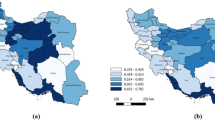Abstract
Vertical specialized trade has become more important globally because of the prevalence of a vertical specialization production mode. Therefore, it is essential to research the relationships between the carbon emissions of intermediate products which have rarely been considered in the field of trading and environmental protection. By establishing a theoretical model for industrial clusters and environmental regulations, this article proved that labor productivity, environmental regulations, and environmental elements productivity were key factors that affected the industrial cluster. Then, in the measurement model established, the key indicators of theoretical model were collected and the effects of factors such as hidden carbon emissions, the degree of vertical specialization, and the different labor–wage ratio on industrial clusters are measured. The article concluded that China has to consider the environment when vigorously advancing the industrial cluster thereby realizing a symbiotic development. The article also carried out an environmental super-efficiency evaluation on the structure of each industry in hope of finding out the direction of optimization of industrial structure.


Similar content being viewed by others
References
Amador, J., & Cabral, S. (2009). Vertical specialization across the world: A relative measure. The North American Journal of Economics and Finance, 20(3), 267–280.
Antweiler, W., Copeland, B., & Taylor, S. (2001). Is free trade good for the environment? American Economic Review, 91(4), 877–908.
Akbostanci, E., TUNÇ, G., & Türüt-Asik, S. (2007). Pollution heaven hypothesis and the role of dirty industries in Turkey’s exports. Environment and Development Economics, 12(02), 297–322.
Cole, A., & Elliott, R. (2005). FDI and the capital intensity of “Dirty” sectors: A missing piece of the pollution haven puzzle. Review of Development Economics, 9(4), 363–383.
Chen, W. Y. (2015). The role of urban green infrastructure in offsetting carbon emissions in 35 major Chinese cities: A nationwide estimate. Cities, 44, 112–120.
Dobre, I., & Alexandru, A. (2009). The impact of unemployment rate on the dimension of shadow economy in Spain: A structural equation approach. European Research Studies Journal, 13(4), 179–197.
Dean, J., & Lovely, M. (2008). Trade growth, production fragmentation, and China’s environment. NBER Working Paper, No. 13860.
Eskeland, S., & Harrison, E. (2003). Moving to greener pastures? Multinationals and the pollution haven hypothesis. Journal of Development Economics, 70(1), 1–23.
Gao, M., Guttikunda, K., & Carmichael, R. (2015). Health impacts and economic losses assessment of the 2013 severe haze event in Beijing area. Science of the Total Environment, 511, 553–561.
Grehter, M., & Melo, D. (2003). Globalization and Dirty Industries: Do Pollution Havens Matter?. No: CEPR Discussion Paper. 3932.
Grossman, M., & Krueger, B. (1995). Economic growth and the environment. Quarterly Journal of Economics, 46(5), 147–162.
Hampf, B., & Rødseth, K. L. (2015). Carbon dioxide emission standards for U.S. power plants: An efficiency analysis perspective. Energy Economics, 50, 140–153.
He, Jie. (2004). Environmental impacts of international trade: The case of industrial emission of sulfur dioxide (SO2) in Chinese provinces. Working Paper.
Hummels, D., Ishii, J., & Yi, K. M. (2001). The nature and growth of vertical specialization in world trade. Journal of International Economics, 54(1), 75–96.
Huysman, S., Sala, S., Mancini, L., Ardente, F., Alvarenga, R. A., De Meester, S., Mathieux, F., & Dewulf. J. (2015). Toward a systematized framework for resource efficiency indicators. Resources, Consevation and Recycling, 95, 68–76.
Jaffe, A. B., Peterson, S. R., & Portney, P. R. (1995). Environmental regulation and the competitiveness of US manufacturing: What does the evidence tell us? Journal of Economic Literature, 33(1), 132–163.
List, A., & Co, Y. (2000). The effects of environmental regulations on foreign direct investment. Journal of Environmental Economics and Management, 40, 1–20.
Liao, H., & Cao, H. S. (2013). How does carbon dioxide emission change with the economic development? Statistical experiences from 132 countries. Global Environmental Change, 23(5), 1073–1082.
Ludema, R. D., & Wooton, I. (1994). Cross-border externalities and trade liberalization: The strategic control of pollution. Canadian Journal of Economics, Canadian Economics Association, 27(4), 950–966.
Melitz, J. (2003). The Impact of trade on itra-industry reallocations and aggregate industry productivity. Econometrica, 71(6), 1695–1725.
Naughton, B. (1999). How much can regional integration do to unify China’s market?. San Diego Mimeo: University of California.
Quiroga, M., Sterner, T., & Persson, M. (2009). Have countries with lax environmental regulations a comparative advantage in polluting industries?. Working Paper.
Wheeler, D. (2001). Racing to the bottom? Foreign investment and air pollution in developing countries. The Journal of Environment & Development, 10(3), 225–245.
Wang, S., & Song, M. (2014). Review of hidden carbon emissions, trade, and labor income share in China, 2001–2011. Energy Policy, 74, 395–405.
Walter, I., & Ugelow, L. (1979). Environmental policies in developing countries. Ambio, 8(23), 102–109.
Young, A. (2000). The razor’s edge: Distortions and incremental reform in the People’s Republic of China. Quarterly Journal of Economics., 115, 1091–1135.
Yu, S., Wei, Y., Guo, H., & Ding, L. (2014). Carbon emission coefficient measurement of the coal-to-power energy chain in China. Applied Energy, 114, 290–300.
Zhang, Y. (2004). Vertical specialization of firms: Evidence from China’s manufacturing sector. Unpublished working paper.
Zeng, D., & Z, L. (2009). Pollution havens and industrial agglomeration. Journal of Environmental Economics and Management, 58(2), 141–153.
Acknowledgments
This work was supported by Major Projects in Philosophy and Social Science Research of the Ministry of Education of China under [Grant No. 14JZD031]; the Program for New Century Excellent Talents in University under [Grant No. NCET-12-0595]; the National Natural Science Foundation of China under [Grant Nos. 71171001 & 71471001]; China Postdoctoral Science Foundation under [Grant No. 2015M570613]; Special Project of Postdoctoral Innovation Projects of Shandong under [Grant No. 201503013] and Natural Science Foundation of Shandong, China under [Grant No. ZR2015PG003].
Author information
Authors and Affiliations
Corresponding author
Rights and permissions
About this article
Cite this article
Wang, SH., Song, ML. & Yu, T. Hidden Carbon Emissions, Industrial Clusters, and Structure Optimization in China. Comput Econ 54, 1319–1342 (2019). https://doi.org/10.1007/s10614-016-9570-7
Accepted:
Published:
Issue Date:
DOI: https://doi.org/10.1007/s10614-016-9570-7




